Saturday, March 06, 2021
Little salute to Leeds and Northrup, part 1
In terms of 'occupational categories', Leeds and Northrup was in the same business as GenRad. Both made precisely calibrated components for industrial or lab or legalistic uses. Beyond this narrow area of overlap, each had a completely different focus. GenRad focused on light and sound, making stroboscopes and color meters for light, and oscillators and frequency analyzers for sound. LN focused more on industrial processes, making measurement systems for chemical and metals plants.
= = = = =
Leeds and Northrup was a much larger outfit than GenRad. Their catalogs showed their main office:
 The factory covered a huge acreage in central Philadelphia. Main office is in the center, facing left.
The factory covered a huge acreage in central Philadelphia. Main office is in the center, facing left.
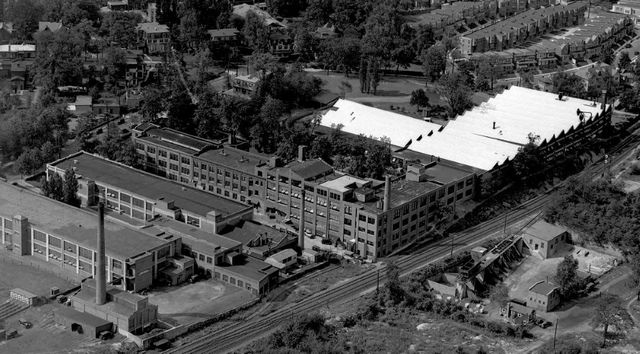 LN was still highly active in the 1970s, then faded out of business around 1980 like everything else in this totally fucked former "country".
The factory is still there behind a cemetery-like fence, presumably brownfielded by demonic EPA to insure that nobody ever tries to make things or develop skills ever again. NEVER AGAIN.
LN was still highly active in the 1970s, then faded out of business around 1980 like everything else in this totally fucked former "country".
The factory is still there behind a cemetery-like fence, presumably brownfielded by demonic EPA to insure that nobody ever tries to make things or develop skills ever again. NEVER AGAIN.
 = = = = =
As I mentioned last week, LN also sold preselected kits for educational use. Real learning requires close contact and constant use of real components making real stuff.
The kit for measuring conductivity, as it appeared in the catalog:
= = = = =
As I mentioned last week, LN also sold preselected kits for educational use. Real learning requires close contact and constant use of real components making real stuff.
The kit for measuring conductivity, as it appeared in the catalog:
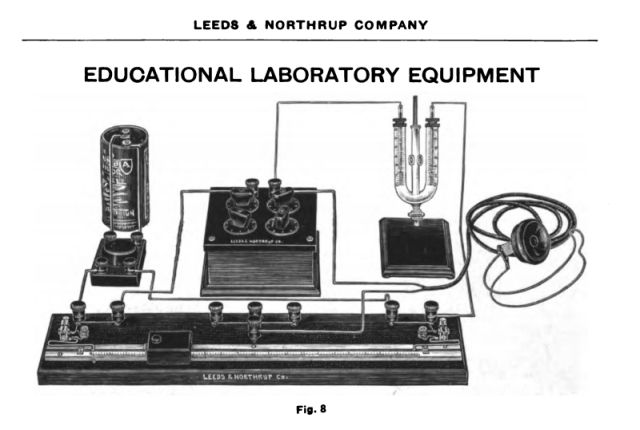 My version, in use by Polistra and Happystar:
My version, in use by Polistra and Happystar:
 This was a classic bridge or balance.
This was a classic bridge or balance.
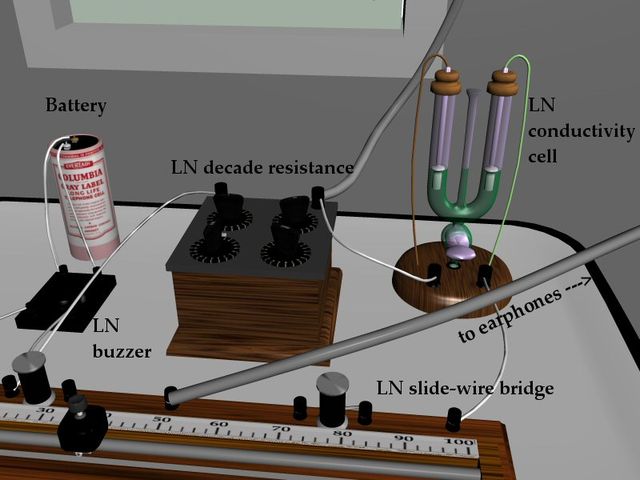 The slide-wire bridge is the scale with fulcrum and adjusting weight. The decade box is the set of fixed weights on one side of the balance. The conductivity cell is the unknown weight. You'd fill it with a liquid of unknown concentration, and determine the concentration or dilution by measuring its resistance to electron flow. The bridge compares the unknown item to the known item, with the decade box (fixed weights) setting the approximate weight of the known, and the slide-wire refining the fractional part.
The conductivity cell itself is balancy, like a drain trap with liquid seeking its own level. Each electrode is in a tube, at the same vertical and horizontal position in the same cylinder of liquid. If bubbles or gravity affect the conductivity, the result will be balanced out. Also, the experiment uses AC instead of DC for the same reason. If there's a preference for electron flow in one direction, because of the earth's magnetic field or stronger local fields, the bidirectional current will balance out the magnetic effects.
In this animated schematic the balance arrangement is a bit more obvious:
The slide-wire bridge is the scale with fulcrum and adjusting weight. The decade box is the set of fixed weights on one side of the balance. The conductivity cell is the unknown weight. You'd fill it with a liquid of unknown concentration, and determine the concentration or dilution by measuring its resistance to electron flow. The bridge compares the unknown item to the known item, with the decade box (fixed weights) setting the approximate weight of the known, and the slide-wire refining the fractional part.
The conductivity cell itself is balancy, like a drain trap with liquid seeking its own level. Each electrode is in a tube, at the same vertical and horizontal position in the same cylinder of liquid. If bubbles or gravity affect the conductivity, the result will be balanced out. Also, the experiment uses AC instead of DC for the same reason. If there's a preference for electron flow in one direction, because of the earth's magnetic field or stronger local fields, the bidirectional current will balance out the magnetic effects.
In this animated schematic the balance arrangement is a bit more obvious:
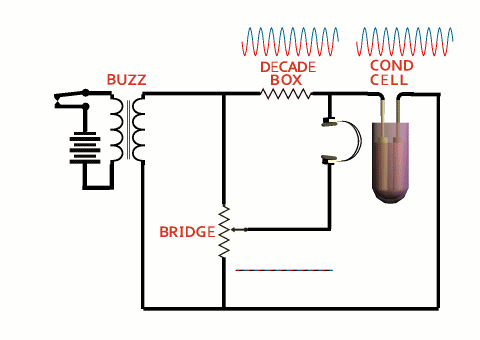 You'd determine the balance by ear, not by eye. First you'd set the fixed weights by the decade box to find the least possible sound; then move the slide-wire back and forth to find the exact zero point or null. The sum of the four decade switches plus the slide-wire setting tells you the resistance of the liquid. (Conductivity is just the reciprocal of resistance. It's easier to use conductivity for objects that have very little friction or resistance, and easier to use R for higher friction.)
= = = = =
Liquids were a prominent feature of labwork in those days, and ALSO a prominent feature of real computing and measuring devices. I'll focus next on an unexpected alternate universe of wet electronics, the path not taken.
= = = = =
Graphic sidenote: My semi-3d schematics revert to a common practice in magazines and books of the 1920s, like this:
You'd determine the balance by ear, not by eye. First you'd set the fixed weights by the decade box to find the least possible sound; then move the slide-wire back and forth to find the exact zero point or null. The sum of the four decade switches plus the slide-wire setting tells you the resistance of the liquid. (Conductivity is just the reciprocal of resistance. It's easier to use conductivity for objects that have very little friction or resistance, and easier to use R for higher friction.)
= = = = =
Liquids were a prominent feature of labwork in those days, and ALSO a prominent feature of real computing and measuring devices. I'll focus next on an unexpected alternate universe of wet electronics, the path not taken.
= = = = =
Graphic sidenote: My semi-3d schematics revert to a common practice in magazines and books of the 1920s, like this:
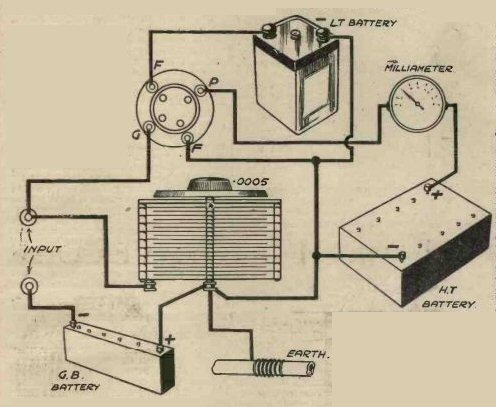 Animation wasn't possible on paper, though I suspect it was used on some flipcards and wheel charts.
Commercial sidenote: There's a lot of well-preserved BEAUTIFUL Leeds and Northrup stuff available on Ebay, at remarkably low prices. Most of the available GenRad equipment is far more expensive. I don't know what accounts for the difference. It's not just age; both companies span the same set of decades.
= = = = =
Part 2 here.
Animation wasn't possible on paper, though I suspect it was used on some flipcards and wheel charts.
Commercial sidenote: There's a lot of well-preserved BEAUTIFUL Leeds and Northrup stuff available on Ebay, at remarkably low prices. Most of the available GenRad equipment is far more expensive. I don't know what accounts for the difference. It's not just age; both companies span the same set of decades.
= = = = =
Part 2 here.
 The factory covered a huge acreage in central Philadelphia. Main office is in the center, facing left.
The factory covered a huge acreage in central Philadelphia. Main office is in the center, facing left.
 LN was still highly active in the 1970s, then faded out of business around 1980 like everything else in this totally fucked former "country".
The factory is still there behind a cemetery-like fence, presumably brownfielded by demonic EPA to insure that nobody ever tries to make things or develop skills ever again. NEVER AGAIN.
LN was still highly active in the 1970s, then faded out of business around 1980 like everything else in this totally fucked former "country".
The factory is still there behind a cemetery-like fence, presumably brownfielded by demonic EPA to insure that nobody ever tries to make things or develop skills ever again. NEVER AGAIN.
 = = = = =
As I mentioned last week, LN also sold preselected kits for educational use. Real learning requires close contact and constant use of real components making real stuff.
The kit for measuring conductivity, as it appeared in the catalog:
= = = = =
As I mentioned last week, LN also sold preselected kits for educational use. Real learning requires close contact and constant use of real components making real stuff.
The kit for measuring conductivity, as it appeared in the catalog:
 My version, in use by Polistra and Happystar:
My version, in use by Polistra and Happystar:
 This was a classic bridge or balance.
This was a classic bridge or balance.
 The slide-wire bridge is the scale with fulcrum and adjusting weight. The decade box is the set of fixed weights on one side of the balance. The conductivity cell is the unknown weight. You'd fill it with a liquid of unknown concentration, and determine the concentration or dilution by measuring its resistance to electron flow. The bridge compares the unknown item to the known item, with the decade box (fixed weights) setting the approximate weight of the known, and the slide-wire refining the fractional part.
The conductivity cell itself is balancy, like a drain trap with liquid seeking its own level. Each electrode is in a tube, at the same vertical and horizontal position in the same cylinder of liquid. If bubbles or gravity affect the conductivity, the result will be balanced out. Also, the experiment uses AC instead of DC for the same reason. If there's a preference for electron flow in one direction, because of the earth's magnetic field or stronger local fields, the bidirectional current will balance out the magnetic effects.
In this animated schematic the balance arrangement is a bit more obvious:
The slide-wire bridge is the scale with fulcrum and adjusting weight. The decade box is the set of fixed weights on one side of the balance. The conductivity cell is the unknown weight. You'd fill it with a liquid of unknown concentration, and determine the concentration or dilution by measuring its resistance to electron flow. The bridge compares the unknown item to the known item, with the decade box (fixed weights) setting the approximate weight of the known, and the slide-wire refining the fractional part.
The conductivity cell itself is balancy, like a drain trap with liquid seeking its own level. Each electrode is in a tube, at the same vertical and horizontal position in the same cylinder of liquid. If bubbles or gravity affect the conductivity, the result will be balanced out. Also, the experiment uses AC instead of DC for the same reason. If there's a preference for electron flow in one direction, because of the earth's magnetic field or stronger local fields, the bidirectional current will balance out the magnetic effects.
In this animated schematic the balance arrangement is a bit more obvious:
 You'd determine the balance by ear, not by eye. First you'd set the fixed weights by the decade box to find the least possible sound; then move the slide-wire back and forth to find the exact zero point or null. The sum of the four decade switches plus the slide-wire setting tells you the resistance of the liquid. (Conductivity is just the reciprocal of resistance. It's easier to use conductivity for objects that have very little friction or resistance, and easier to use R for higher friction.)
= = = = =
Liquids were a prominent feature of labwork in those days, and ALSO a prominent feature of real computing and measuring devices. I'll focus next on an unexpected alternate universe of wet electronics, the path not taken.
= = = = =
Graphic sidenote: My semi-3d schematics revert to a common practice in magazines and books of the 1920s, like this:
You'd determine the balance by ear, not by eye. First you'd set the fixed weights by the decade box to find the least possible sound; then move the slide-wire back and forth to find the exact zero point or null. The sum of the four decade switches plus the slide-wire setting tells you the resistance of the liquid. (Conductivity is just the reciprocal of resistance. It's easier to use conductivity for objects that have very little friction or resistance, and easier to use R for higher friction.)
= = = = =
Liquids were a prominent feature of labwork in those days, and ALSO a prominent feature of real computing and measuring devices. I'll focus next on an unexpected alternate universe of wet electronics, the path not taken.
= = = = =
Graphic sidenote: My semi-3d schematics revert to a common practice in magazines and books of the 1920s, like this:
 Animation wasn't possible on paper, though I suspect it was used on some flipcards and wheel charts.
Commercial sidenote: There's a lot of well-preserved BEAUTIFUL Leeds and Northrup stuff available on Ebay, at remarkably low prices. Most of the available GenRad equipment is far more expensive. I don't know what accounts for the difference. It's not just age; both companies span the same set of decades.
= = = = =
Part 2 here.
Animation wasn't possible on paper, though I suspect it was used on some flipcards and wheel charts.
Commercial sidenote: There's a lot of well-preserved BEAUTIFUL Leeds and Northrup stuff available on Ebay, at remarkably low prices. Most of the available GenRad equipment is far more expensive. I don't know what accounts for the difference. It's not just age; both companies span the same set of decades.
= = = = =
Part 2 here.Labels: Alternate universe, Equipoise, Experiential education, Metrology
